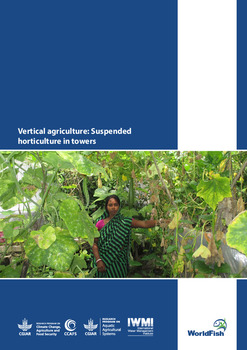Please use this identifier to cite or link to this item:
https://hdl.handle.net/20.500.12348/200
Vertical agriculture: Suspended horticulture in towers
| dc.creator | Hossain, E. | |
| dc.creator | Nurun Nabi, S. | |
| dc.creator | Kaminski, A. | |
| dc.date.accessioned | 2018-07-31T08:53:34Z | |
| dc.date.available | 2018-07-31T08:53:34Z | |
| dc.date.issued | 2015 | |
| dc.identifier | 3875_2015-29.pdf | |
| dc.identifier.citation | Penang, Malaysia: WorldFish. Program Brief: 2015-29 | |
| dc.identifier.uri | https://hdl.handle.net/20.500.12348/200 | |
| dc.description.abstract | The farmers of Bangladesh face many challenges associated with climate change and increases in population. Rising salinity, waterlogging, flooding and storm surges, coupled with a growing population that is expected to reach 250 million people by the year 2050, have resulted in a decrease in cultivable land for vegetable production. This brief descirbes how vertical agriculture can address the loss of cultivable land by maximizing the space around households and suspending horticulture production along trees, houses and bamboo structures. Vertical agriculture results in higher production rates and the use of less land and water. | |
| dc.format | application/pdf | |
| dc.publisher | WorldFish | |
| dc.rights | CC BY 4.0 | |
| dc.title | Vertical agriculture: Suspended horticulture in towers | |
| dc.type | Brief | |
| dcterms.bibliographicCitation | Hossain, E.; Nurun Nabi, S.M.; Kaminski, A. (2015). Vertical agriculture: Suspended horticulture in towers. Penang, Malaysia: WorldFish. Program Brief: 2015-29 | |
| cg.contributor.crp | Aquatic Agricultural Systems | |
| cg.contributor.crp | Climate Change, Agriculture and Food Security | |
| cg.coverage.country | Bangladesh | |
| cg.coverage.region | Southern Asia | |
| cg.identifier.worldfish | 3875 | |
| cg.subject.agrovoc | climate change | |
| cg.subject.agrovoc | resilience | |
| cg.subject.agrovoc | sustainable agriculture | |
| cg.subject.worldfish | small-scale agriculture | |
| cg.identifier.status | Open access | |
| cg.description.theme | Climate change |
Files in this item
This item appears in the following Collection(s)
-
Climate Change [204]
